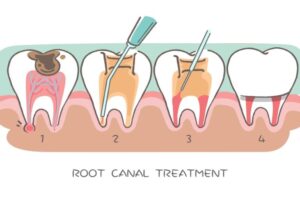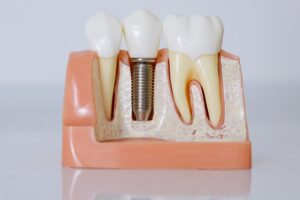Toothaches Don’t Come With Warnings
Life has a sneaky way of throwing curveballs. A missed deadline, a flat tire, a sudden fever. And then there’s the dreaded toothache — the kind that doesn’t just hurt, but hijacks your whole life.
At first, it’s subtle. Cold water stings, hot chai burns, and you convince yourself, “Maybe I brushed too hard.” But then comes that one night. It’s 3 AM, and you’re clutching your jaw, pacing the room, silently bargaining with the universe: “I swear I’ll floss every day if you just make this stop.”
Eventually, you drag yourself to the dental clinic. The dentist examines you, taps your tooth, looks concerned, and finally says the sentence nobody wants to hear:
“You need a root canal.”
For many, those words feel like a death sentence. Images of drills, pain, and endless procedures flood the mind. But here’s the truth most people don’t realize — the root canal isn’t the enemy. The infection is. The root canal is the hero, the procedure that swoops in to save your tooth from certain death.
And when the root canal is done, you walk out of the clinic relieved. The pain is gone, the infection is gone, and you think the crisis is over. Except… not quite.
Because the story doesn’t end until that tooth gets its armor — the dental crown.
What Exactly Is a Dental Crown?
Forget the clinical definitions. A dental crown is armor. It’s a helmet for a soldier that’s been through war. It’s the protective shield that lets a weakened tooth function again.
After a root canal, your tooth is hollowed out. The infected pulp and nerve tissue are gone, but so is much of the tooth’s natural strength. Imagine a clay pot — scoop out the insides and it becomes fragile. Even a small tap could crack it.
That’s where the dental crown steps in. It covers the tooth, restores its shape, and gives it back the strength to chew without fear. Some people call it a dental cap, which honestly isn’t a bad description. Whether you say crown or cap, the job is the same — protection that looks, feels, and works like a natural tooth.
Why Your Root Canal Isn’t Complete Without a Dental Crown
Here’s a truth bomb: if you skip the crown after a root canal, you’re gambling with your tooth’s future.
The infection might be gone, but the tooth is now hollow and fragile. One bad bite on something as harmless as popcorn, and snap — the tooth fractures. And here’s the kicker: once a tooth breaks beyond repair, no dental cap or crown can save it. Extraction becomes the only option.
From there, your only way back is a dental implant. Don’t get me wrong — implants are amazing. But they’re also surgical, expensive, and time-consuming. Suddenly, that crown you thought was optional starts looking like a bargain.
Think of it this way: the root canal is like fixing the engine of your car. The crown is putting the hood back on to protect it. Without the hood, the engine won’t last long.
Read More – Root Canal Treatment Unmasked: Fear, Money, and Saving Your Tooth
The Emotional Journey of Getting a Crown
Dentistry is never just about teeth. It’s about emotions, too.
- Before the crown: You’re exhausted. You’ve survived the root canal and think you’re done.
- During the crown process: You’re skeptical. Why is the dentist filing your tooth down? What’s with the gooey material you’re biting into for impressions? Why a temporary cap first?
- After the crown is placed: Relief. That first bite into food without worry. That first smile without fear. That first sip of coffee that feels blissfully normal again.
I’ve had patients tear up the moment their permanent dental crown went in — not from pain, but from sheer gratitude.
Dental Crown vs. Dental Cap: Is There a Difference?
This question comes up all the time. Patients say “cap,” dentists say “crown.” The truth? They’re the same thing. “Dental crown” is the formal term, “dental cap” is the everyday word patients use. Don’t overthink it. What matters is getting your tooth the protection it needs.
Types of Dental Crowns Explained Simply
Crowns aren’t one-size-fits-all. They come in varieties, and each has its strengths:
- Metal crowns: Incredibly durable, shiny, and perfect for molars that no one sees.
- Porcelain-fused-to-metal (PFM): A hybrid — tooth-colored on the outside, metal inside. Strong and reliable, but may show a faint line at the gum over time.
- All-ceramic or porcelain: The beauty queens. Perfect for front teeth where looks matter most. They mimic natural enamel beautifully.
- Zirconia crowns: The modern MVP. Strong as metal, aesthetic as porcelain. A favorite for both front and back teeth.
Which one should you pick? That depends on your tooth’s location, your budget, and your priorities. If strength matters most, metal or zirconia. If appearance is king, porcelain or ceramic.
The Modern Crown Procedure: What to Expect
Let’s walk through what actually happens when you get a crown. Knowledge is power, and understanding the process often calms those pre-appointment jitters.
- First Visit: Preparation Day
After numbing your tooth (yes, anesthesia is your friend here), your dentist reshapes the tooth. Think of it as preparing a foundation for a house—it needs the right dimensions for the crown to fit perfectly. This involves removing a thin layer from the top and sides of your tooth.
Next comes the impression. Traditional methods use that goopy material that feels strange but captures every contour of your mouth. Many modern practices now use digital scanners—a wand that takes thousands of pictures in seconds, creating a 3D model of your tooth without any goop.
Before you leave, you’ll get a temporary crown—think of it as a rental home while your permanent one is being built. It protects your tooth but isn’t designed for long-term use.
- The Lab Magic Between Visits
While you’re going about your life, dental technicians are crafting your permanent crown. If you’ve chosen a ceramic or porcelain option, they’re meticulously matching the color to your surrounding teeth. For zirconia crowns, they’re using high-tech milling machines to create a crown with precise measurements down to the micron.
- Second Visit: Coronation Day
When you return, the temporary comes off, and your dentist test-fits your permanent crown. This is critical—they’re checking bite alignment, margins (where crown meets tooth), and aesthetics. Adjustments are made right there if needed.
Once everything is perfect, the crown is cemented into place. That cement is specially designed to create a seal that keeps bacteria out while bonding securely to both your tooth and the crown.
Living with Your Crown: The First Week
The first days with your new crown require some adjustment:
Temperature sensitivity may occur briefly. Your tooth is adapting to its new protective layer. This typically fades within days.
Flossing might feel different. Don’t skip it, but be gentle around the crown margins at first. Special floss threaders can help if traditional flossing feels awkward.
Your bite might feel slightly different. Your brain notices even microscopic changes. Most people adapt within days, but if something feels persistently off, a quick adjustment visit can fix it.
The Dental Crown Revolution: Digital Dentistry
The evolution of crown technology has been remarkable. CAD/CAM systems now allow some practices to create same-day crowns. You walk in with a damaged tooth and walk out hours later with a permanent crown—no temporary, no second visit.
These systems use 3D printing or milling technology to create your crown while you wait. The precision is exceptional, and the convenience factor is changing how patients experience restorative dentistry.
The Cost of a Dental Crown: An Investment, Not an Expense
Let’s address the elephant in the room: cost. Yes, a dental crown can feel pricey. But skipping it doesn’t actually save you money.
Here’s why: without a crown, a root canal-treated tooth is vulnerable. When it fractures, your only option left is extraction, followed by an implant. And implants? They’re far more expensive, involve surgery, and take months to complete.
I’ve seen patients hesitate over a crown, only to return six months later needing an implant that cost them three times as much. That’s why I always explain — the crown isn’t just dental work. It’s an investment in keeping your natural tooth.
The Craftsmanship Behind a Crown
A well-made dental crown is half science, half art. Too high, and your bite feels off. Too low, and food gets stuck. Too bright, and it looks fake. Done right, the crown disappears into your smile. It feels so natural that you forget which tooth was even treated. That’s the mark of a skilled dentist and a good dental lab.
How Long Does a Crown Last?
With proper care, a quality crown can last 10–20 years, sometimes longer. Some even last a lifetime. The secret? Consistent oral hygiene and smart habits.
- Brush twice daily.
- Floss regularly (yes, around the crown too).
- Don’t chew ice cubes or try to crack nuts with your teeth.
- Visit your dentist for regular checkups.
Treat your crown like a teammate, not a tool, and it will serve you faithfully.
Life Without a Crown: The Alternate Ending
Imagine this scenario. You complete your root canal but skip the crown. For a while, everything feels fine. Then one day, you’re enjoying popcorn and — crack! The tooth fractures. Now it’s unsalvageable. Extraction becomes inevitable.
Once the tooth is gone, the chain reaction begins: shifting teeth, bite changes, difficulty chewing, maybe even bone loss. Patients who’ve been down that road almost always say the same thing:
“I wish I had just gotten the crown.”
The Psychological Impact Nobody Talks About
Teeth aren’t just tools for chewing — they’re tied to your identity. Losing a tooth changes how you smile, how you eat, even how you feel about yourself. A dental crown isn’t just about dentistry. It’s about confidence, dignity, and peace of mind.
I once had a patient say after receiving her dental cap, “I feel like me again.” That one sentence says more than any textbook ever could.
Read More – Dental Crowns and Bridges in Gurgaon – Restore Your Smile with Confidence
The Bottom Line
Let’s not sugarcoat it: a dental crown after a root canal isn’t optional. It’s protection. Call it a crown, call it a dental cap — either way, it’s the finishing touch that ensures your tooth survives for years to come.
Yes, it costs money. Yes, it takes an extra visit. But the alternative — a broken tooth, an extraction, an implant — costs far more in pain, money, and time.
So don’t stop halfway. Don’t waste your root canal by leaving your tooth unprotected.
Get the crown. Save the tooth. Protect your smile. Because at the end of the day, the dental crown isn’t just dentistry. It’s your tooth’s second chance at life.
FAQ: Dental Crowns
Nothing. They’re two names for the same thing.
Because the tooth becomes fragile after a root canal. A crown strengthens it and prevents fractures.
On average, 10–15 years, sometimes decades with good care.
They’re an investment. Costs vary by material, but they’re far cheaper than losing the tooth and needing an implant later.
Yes. Modern ceramic and zirconia crowns look identical to natural teeth when crafted well.
Absolutely. Once cemented, you can chew, bite, and live normally. Just avoid using your teeth as tools.
You risk the tooth breaking beyond repair, which usually leads to extraction.







